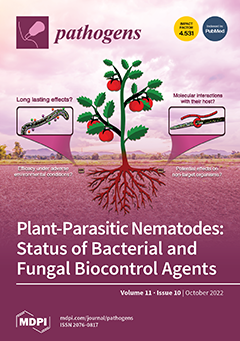(1) Background:
Toxoplasma gondii is a widespread zoonotic agent that greatly impacts Public Health, being responsible for one of the most important parasitic zoonosis worldwide.
T. gondii has a heteroxenous life cycle, with cats being the definitive hosts and all warm-blooded animals, including
[...] Read more.
(1) Background:
Toxoplasma gondii is a widespread zoonotic agent that greatly impacts Public Health, being responsible for one of the most important parasitic zoonosis worldwide.
T. gondii has a heteroxenous life cycle, with cats being the definitive hosts and all warm-blooded animals, including humans, being intermediate hosts. Veterinary practitioners (VP) may be at a higher risk than the general population for
T. gondii infection, as they have direct and daily contact with many animal species. The aim of the present study was to ascertain if VP were more likely to be anti-
T. gondii IgG seropositive than the general population, as well as to understand if age, accidents with blood-contaminated sharps (cross-blood contamination), gender, working years, and geographic regions play a role as risk factors for
T. gondii infection. For this purpose, a case–control study using archived samples was performed. (2) Methods: A total of 350 veterinary practitioners were tested using a commercial semiquantitative enzyme immunoassay for anti-
T. gondii IgG. From the general population, 175 anonymous volunteers (matched with cases by region, age, and gender) were studied for anti-
T. gondii IgG. (3) Results: There was no statistical difference found between the presence of anti-
T. gondii IgG in practitioners (26%; CI = 21.40–30.60%) and the general population (33.14%; CI = 26.17–40.12%) (
p = 0.108). Univariate and multivariate analysis showed that only age (older groups) was found to be associated with a higher prevalence of anti-
T. gondii IgG, with significant
p values (
p < 0.05) for both univariate and multivariate analysis. (4) Conclusions: To the best of our knowledge, this is the first case–control study fully focused on the prevalence of anti-
T. gondii IgG in VP in Portugal, showing that there was no significant risk for
T. gondii infection in veterinarians exposed daily and repeatedly to different species of animals.
Full article






